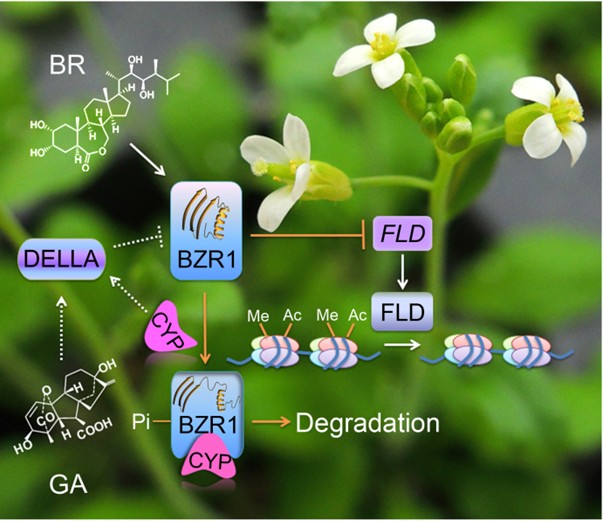Flowering is one of the most important events in the life cycle of higher plants. It is a transition from vegetative growth to reproductive development, which is regulated by lots of key regulating genes as well as the precise regulation of histone modification. The transcription of the key factors of hormones signaling such as Brassinosteroids (BRs) and gibberellic acid (GAs) are involved in this process, but it is unknown how the conformation changes of protein mediates flowering. Dr. Kang Chong's Group and his collaborators found that BRASSINAZOLE-RESISTANT1 (BZR1) directly regulatesFLDencoding a putative histone demethylase to mediate flowering. The protein conformation of BZR1 which is altered by a cyclophilin (CYP20-2) due to its PPIase activity, impacts transcription of its target gene FLD for regulation flowering. Differences in activity and substrate preference of CYP20-2 from Arabidopsis and wheat led to altered flowering patterns. This novel mechanism "conformation changes of protein mediated flowering” shed light on BZR1-mediated flowering and help elucidate the post-translation level mechanism of CYP-mediated conformational changes in BZR1 to regulate its function.
This work has been published in The Plant Cell online (Zhang et al., 2013, doi: 10.1105/tpc.113.110296). It was supported by the National Natural Science Foundation of China (31070677) and the Foundation for Innovative Research Groups of the National Natural Science Foundation of China (31121065).

Figure 1 Hypothetical model of conformation changes of protein mediated flowering BZR1, a key transcriptional factor of BR signaling, binds the promoter of a histone demethylase gene FLD to regulate flowering in Arabidopsis. The Cyclophilin CYP20-2 modulates the conformation of BZR1 and regulates the process of its degradation.
Flowering is one of the most important events in the life cycle of higher plants. It is a transition from vegetative growth to reproductive development, which is regulated by lots of key regulating genes as well as the precise regulation of histone modification. The transcription of the key factors of hormones signaling such as Brassinosteroids (BRs) and gibberellic acid (GAs) are involved in this process, but it is unknown how the conformation changes of protein mediates flowering. Dr. Kang Chong's Group and his collaborators found that BRASSINAZOLE-RESISTANT1 (BZR1) directly regulatesFLDencoding a putative histone demethylase to mediate flowering. The protein conformation of BZR1 which is altered by a cyclophilin (CYP20-2) due to its PPIase activity, impacts transcription of its target gene FLD for regulation flowering. Differences in activity and substrate preference of CYP20-2 from Arabidopsis and wheat led to altered flowering patterns. This novel mechanism "conformation changes of protein mediated flowering” shed light on BZR1-mediated flowering and help elucidate the post-translation level mechanism of CYP-mediated conformational changes in BZR1 to regulate its function.
This work has been published in The Plant Cell online (Zhang et al., 2013, doi: 10.1105/tpc.113.110296). It was supported by the National Natural Science Foundation of China (31070677) and the Foundation for Innovative Research Groups of the National Natural Science Foundation of China (31121065).

Figure 1 Hypothetical model of conformation changes of protein mediated flowering BZR1, a key transcriptional factor of BR signaling, binds the promoter of a histone demethylase gene FLD to regulate flowering in Arabidopsis. The Cyclophilin CYP20-2 modulates the conformation of BZR1 and regulates the process of its degradation.
